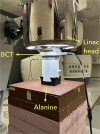Characterization of a shielded beam current transformer for ultra-high dose rate (FLASH) electron beam monitoring and dose reporting
- PMID: 40473411
- PMCID: PMC12257996
- DOI: 10.1002/mp.17927
Characterization of a shielded beam current transformer for ultra-high dose rate (FLASH) electron beam monitoring and dose reporting
Abstract
Background: Real-time beam monitoring and accurate dose reporting is challenging in ultra-high dose rate (UHDR) electron beams. Although beam current transformers (BCTs) can effectively track parameters such as pulse width (PW) and repetition frequency for UHDR electron beams, recent work has highlighted their sensitivity to electric fields induced by transient charge buildup in irradiated media under UHDR conditions.
Purpose: This study evaluates the performance of a novel electrostatically shielded BCT for real-time, high-accuracy dose monitoring in UHDR electron beams.
Methods: Irradiations were conducted using the Mobetron linear accelerator configured for UHDR electron beams with energies of 6 and 9 MeV. A shielded BCT was implemented to monitor beam delivery, with dose calibration established using alanine dosimeters in solid water phantoms. Dose stability was assessed over short (7-day) and long (16-week) periods. The BCT's response to variations in PW, pulse number, and pulse repetition frequency was also evaluated to determine its robustness across beam configurations.
Results: The BCT showed high reproducibility and accuracy, with standard deviations of the difference between BCT-predicted and alanine-measured doses within 0.21% over short-term measurements and 0.57% over long-term measurements, even when subject to large (10%) machine output adjustments. When varying beam parameters, the BCT maintained accurate dose prediction within 1.0% and 1.4% of alanine measurements for 6 and 9 MeV, respectively, with high linearity ( 0.9997) across total doses.
Conclusion: Shielded BCTs provide a stable and accurate solution for real-time dose monitoring in FLASH radiotherapy, demonstrating robustness against output fluctuations and beam parameter variations. While further calibration standardization is required, this study supports the feasibility of using shielded BCTs for reliable UHDR dose monitoring, facilitating safe and precise implementation of FLASH radiotherapy in preclinical and clinical settings.
Keywords: FLASH radiotherapy; beam current transformer; electron beams.
© 2025 The Author(s). Medical Physics published by Wiley Periodicals LLC on behalf of American Association of Physicists in Medicine.
Conflict of interest statement
The authors declare no conflicts of interest.
Figures








Similar articles
-
Dosimetric calibration of anatomy-specific ultra-high dose rate electron irradiation platform for preclinical FLASH radiobiology experiments.Med Phys. 2024 Dec;51(12):9166-9178. doi: 10.1002/mp.17432. Epub 2024 Sep 27. Med Phys. 2024. PMID: 39331834 Free PMC article.
-
Characterization of commercial detectors for absolute proton UHDR dosimetry on a compact clinical proton synchrocyclotron.Med Phys. 2025 Jul;52(7):e17847. doi: 10.1002/mp.17847. Epub 2025 Apr 23. Med Phys. 2025. PMID: 40268691
-
Electron beam response corrections for an ultra-high-dose-rate capable diode dosimeter.Med Phys. 2024 Aug;51(8):5738-5745. doi: 10.1002/mp.17121. Epub 2024 May 19. Med Phys. 2024. PMID: 38762909 Free PMC article.
-
A systematic review of electron FLASH dosimetry and beam control mechanisms utilized with modified non-clinical LINACs.J Appl Clin Med Phys. 2025 Apr;26(4):e70051. doi: 10.1002/acm2.70051. Epub 2025 Mar 19. J Appl Clin Med Phys. 2025. PMID: 40108673 Free PMC article.
-
Management of urinary stones by experts in stone disease (ESD 2025).Arch Ital Urol Androl. 2025 Jun 30;97(2):14085. doi: 10.4081/aiua.2025.14085. Epub 2025 Jun 30. Arch Ital Urol Androl. 2025. PMID: 40583613 Review.
References
-
- Bourhis J, Montay‐Gruel P, Jorge PG, et al. Clinical translation of FLASH radiotherapy: why and how?. Radiother Oncol. 2019;139:11‐17. - PubMed
-
- Friedl AA, Prise KM, Butterworth KT, Montay‐Gruel P, Favaudon V. Radiobiology of the FLASH effect. Med Phys. 2022;49(3):1993‐2013. - PubMed
-
- Vozenin MC, De Fornel P, Petersson K, et al. The advantage of FLASH radiotherapy confirmed in mini‐pig and cat‐cancer patients. Clin Cancer Res. 2019;25(1):35‐42. - PubMed
-
- Moeckli R, Gonçalves Jorge P, Grilj V, et al. Commissioning of an ultra‐high dose rate pulsed electron beam medical LINAC for FLASH RT preclinical animal experiments and future clinical human protocols. Med Phys. 2021;48(6):3134‐3142. doi: 10.1002/mp.14885 - DOI - PubMed
MeSH terms
Grants and funding
LinkOut - more resources
Full Text Sources

